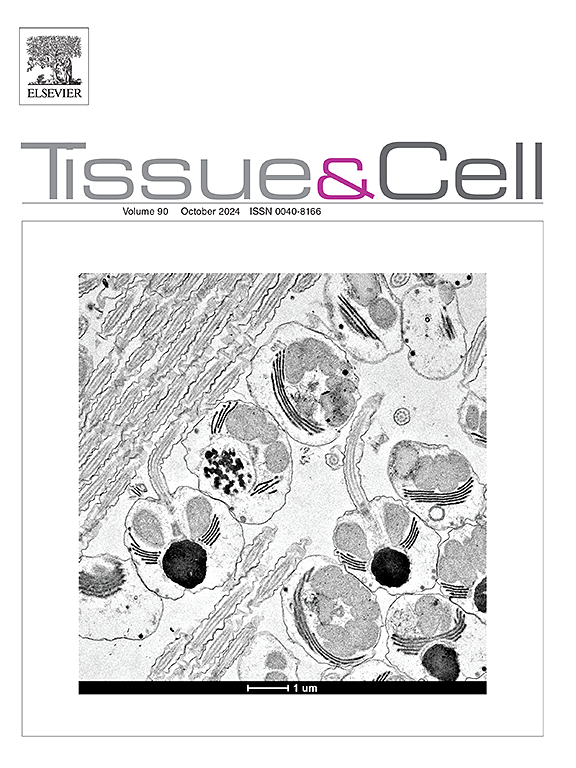探索细胞死亡的复杂性:洞察意外和程序性细胞死亡
IF 2.5
4区 生物学
Q1 ANATOMY & MORPHOLOGY
引用次数: 0
摘要
细胞死亡是一种重要的生物现象,可分为意外细胞死亡(ACD)和程序性细胞死亡(PCD),每种死亡都表现出不同的信号传导、机理和形态特征。本文全面概述了七种类型的 ACD,包括凝固性、液化性、酪性、脂肪性、纤维素性、坏疽性和继发性坏死,并讨论了它们在缺血和炎症等情况下的病理意义。此外,我们还回顾了十八种形式的多发性坏死,包括自噬、凋亡、坏死凋亡、热凋亡、旁凋亡、铁凋亡、anoikis、entosis、NETosis、eryptosis、parthanatos、有丝分裂,以及新认识到的类型,如methuosis、autosis、alkaliptosis、oxeiptosis、cuprotosis和erebosis。这些细胞死亡模式对细胞过程、发育和疾病(尤其是肿瘤和神经退行性疾病)的影响也包括在内。此外,我们还探讨了各种形式的 PCD 之间的相互影响,强调凋亡机制如何影响坏死和热凋亡等途径。了解这种相互影响对于阐明细胞对应激的反应及其在临床应用和治疗策略中的潜在相关性至关重要。未来的研究应侧重于阐明支配不同形式的 PCD 及其相互作用的分子机制。本文章由计算机程序翻译,如有差异,请以英文原文为准。
Navigating the complexities of cell death: Insights into accidental and programmed cell death
Cell death is a critical biological phenomenon that can be categorized into accidental cell death (ACD) and programmed cell death (PCD), each exhibiting distinct signaling, mechanistic and morphological characteristics. This paper provides a comprehensive overview of seven types of ACD, including coagulative, liquefactive, caseous, fat, fibrinoid, gangrenous and secondary necrosis, discussing their pathological implications in conditions such as ischemia and inflammation. Additionally, we review eighteen forms of PCD, encompassing autophagy, apoptosis, necroptosis, pyroptosis, paraptosis, ferroptosis, anoikis, entosis, NETosis, eryptosis, parthanatos, mitoptosis, and newly recognized types such as methuosis, autosis, alkaliptosis, oxeiptosis, cuprotosis and erebosis. The implications of these cell death modalities for cellular processes, development, and disease—particularly in the context of neoplastic and neurodegenerative disorders—are also covered. Furthermore, we explore the crosstalk between various forms of PCD, emphasizing how apoptotic mechanisms can influence pathways like necroptosis and pyroptosis. Understanding this interplay is crucial for elucidating cellular responses to stress, as well as for its potential relevance in clinical applications and therapeutic strategies. Future research should focus on clarifying the molecular mechanisms that govern different forms of PCD and their interactions.
求助全文
通过发布文献求助,成功后即可免费获取论文全文。
去求助
来源期刊

Tissue & cell
医学-解剖学与形态学
CiteScore
3.90
自引率
0.00%
发文量
234
期刊介绍:
Tissue and Cell is devoted to original research on the organization of cells, subcellular and extracellular components at all levels, including the grouping and interrelations of cells in tissues and organs. The journal encourages submission of ultrastructural studies that provide novel insights into structure, function and physiology of cells and tissues, in health and disease. Bioengineering and stem cells studies focused on the description of morphological and/or histological data are also welcomed.
Studies investigating the effect of compounds and/or substances on structure of cells and tissues are generally outside the scope of this journal. For consideration, studies should contain a clear rationale on the use of (a) given substance(s), have a compelling morphological and structural focus and present novel incremental findings from previous literature.
 求助内容:
求助内容: 应助结果提醒方式:
应助结果提醒方式:


